![]()
SCOPOLAMINE
(a.k.a. HYOSCINE)
Dr Crippen’s Drug,
which is also used to rob people.
![]()
Simon Cotton
University of Birmingham
![]()
Molecule of the Month October 2018
Also available: HTML version.
![]()
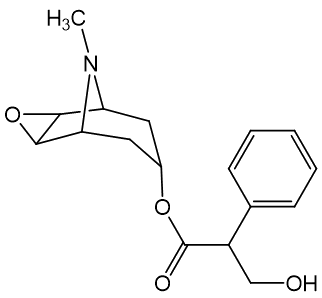
SCOPOLAMINE(a.k.a. HYOSCINE)Dr Crippen’s Drug,
|
 |
Who’s Dr Crippen?Michigan-born Hawley Harvey Crippen (1862-1910) trained in homeopathic medicine and came to England in 1898 with Cora, his second wife, who was a music-hall entertainer. She disappeared in February 1910, sparking an investigation. What happened to Cora?Cora, also known under her stage name of Belle Elmore, had complained of feeling unwell at a dinner chez Crippen on January 31st, where another couple, Paul and Clara Martinetti, were guests, and that was the last time she was seen. Crippen told some people that she had gone back to the USA and then towards the end of March he wrote to the Martinettis saying that he’d heard that Cora was dangerously ill, followed four days later by a telegram announcing her death. He also announced her death in the press. It was subsequently found that he’d had given a choice of Cora’s jewellery and clothing to a young woman called Ethel le Neve, who was his secretary and mistress, whilst he’d been selling other items of jewellery that February. It wasn’t until some of Cora’s friends from the USA came over in June, and said that she definitely wasn’t in America, that people started to be suspicious and contacted Scotland Yard. Inspector Walter Drew called on Crippen at home on July 8th and interviewed him. Crippen seems to have suspected that the police were onto him, so the next day he and Ethel (who by this time was disguised as a young boy) took the boat train from Liverpool Street station and made for Brussels. They caught a ship, the SS Montrose, on July 20th, heading for Quebec, under the identity of a Mr Robinson and his son. |
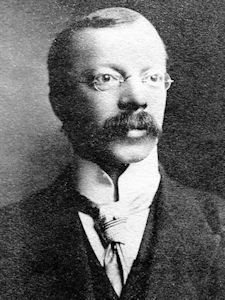 Dr Crippen in 1910. [Public domain, via Wikimedia Commons] |
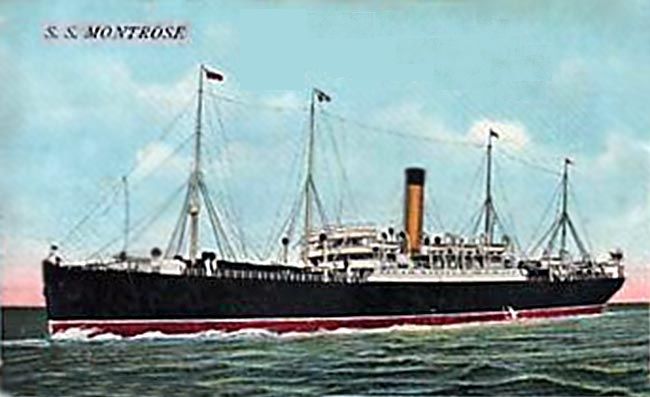
The SS Montrose
Meanwhile Inspector Drew had searched Crippen’s house. One of his team spotted some loose bricks in the cellar floor, when they lifted them they uncovered bodily remains. A warrant was issued for Crippen’s arrest on July 16th.
The discovery of the human remains and the disappearance of Crippen became hot news, and not just in England. Unluckily for Crippen, the Montrose had been fitted with radio communication, which had been invented only a few years earlier by Marconi. As a result, Captain Kendall of the Montrose was in radio contact with land and knew of the disappearance of Crippen, identifying him among the passengers. He was soon suspicious of the effeminate ‘son’, observing him holding hands with Crippen. He radioed England, and Inspector Drew hot-footed it to Liverpool, catching a fast liner, the SS Laurentic, which docked in Canada before the Montrose, so he was able to board the Montrose before it made land, and arrested Crippen and Le Neve. Crippen was therefore the first criminal suspect to be captured with the aid of wireless telegraphy (radio).
It began on Tuesday October 18th 1910. The Home Office pathologist who examined the remains found in the cellar found that the stomach, kidneys, liver and intestines all contained an alkaloid, which he eventually narrowed down to scopolamine, something that Crippen was known to have purchased from a pharmacist on January 19th. The jury were sent out on Saturday October 22nd, and were back with a guilty verdict in 27 minutes flat. Crippen was sentenced to death and following an unsuccessful appeal was hanged on November 23rd. Ethel le Neve was tried separately on Monday October 25th and found not guilty; she subsequently married and lived until 1967.
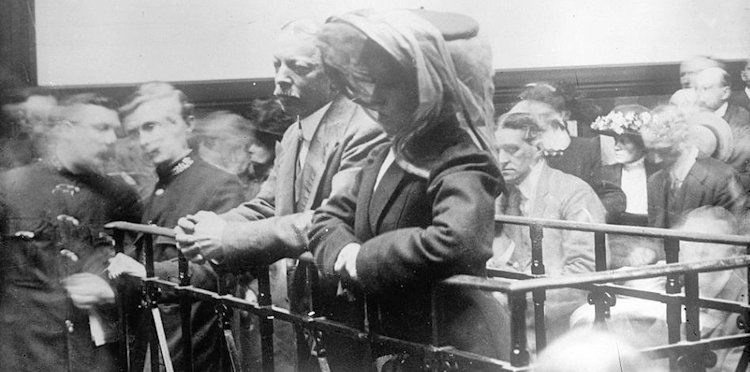
Dr Crippen and Ethel Le Neve on trial.
[Public domain, via Wikimedia Commons]
In a controversial turn of events, results were published in 2010 of DNA tests on scar tissue samples reportedly used by the pathologist in the case; it was claimed that comparison with DNA samples of maternal descendents of Cora Crippen shows that the tissues could not have belonged to Mrs Crippen.
What is scopolamine?It’s an alkaloid that a chemist called Albert Ladenburg first isolated from the nightshade plant Scopolia carniolica in 1880. This plant was itself named after an Italian naturalist, Antonio Scopoli, and so the new molecule was called scopolamine. Where is scopolamine found?It’s found in a number of plants (particularly members of the nightshade family), such as deadly nightshade (Solanum dulcamara), mandrake (Mandragora officinarum), henbane (Hyoscyamus niger) which gives it its other common name hyoscine, thorn-apple or jimsonweed (Datura stramonium), scopolia (scopolia carniolica) and angel's trumpets (Brugmansia species, like B. suaveolens). |
 Scopolia carniolica [Photo: Salicyna [CC BY-SA 4.0], from Wikimedia Commons] |
Mandrake had a curious reputation in the Middle Ages (and before that), as it was alleged that when it was dug up, it emitted screams fatal to those in earshot. It was introduced into the Harry Potter books, where Professor Sprout showed her students how to pot mandrakes (all wearing ear-muffs of course).

Professor Sprout hold up a 'mandrake root' in the movie Harry Potter and the Chamber of Secrets.
Does it have any uses?It was once used, in combination with morphine, as an anaesthetic-analgesic in childbirth. One unusual property of scopolamine is to induce ‘twilight sleep’, a state of consciousness lacking in memory. A spin-off from this was the use of scopolamine as a ‘truth serum’. What does that mean?It was believed that under its influence people could only tell the truth. It was used in American and Canadian courts to this effect in the 1920s, but in the following decade it was superseded by barbituric acid derivatives like sodium pentothal [MOTM February 2007], though it also appears to have been used for this purpose in Communist-era Czechoslovakia. Some people may also remember the scene in the 1961 WW2 movie ‘The Guns of Navarone’ where the German general demands that scopolamine be used to interrogate the prisoner (played by Anthony Quayle) left behind by the group. This was a bit of a technical blunder by the screenwriters, however - while scopolamine had been known since 1881 it did not come into commercial or widespread use until 1947, two years after WW2 ended. Also, it was not known to be a truth serum drug until the early 1950s. |
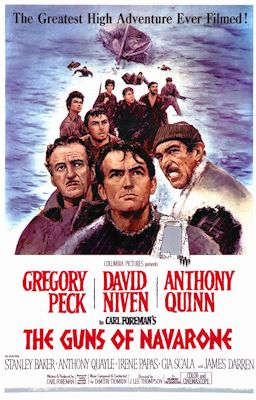 Movie poster of the movie The Guns of Navarone. [Incorporates artwork by Howard Terpning [Public domain], via Wikimedia Commons] |
![]()
![]()
![]() Back to Molecule of the Month page. [DOI:10.6084/m9.figshare.7177916]
Back to Molecule of the Month page. [DOI:10.6084/m9.figshare.7177916]